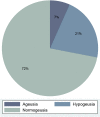Smell, taste and trigeminal disorders in a 65-year-old population
- PMID: 33964881
- PMCID: PMC8105933
- DOI: 10.1186/s12877-021-02242-6
Smell, taste and trigeminal disorders in a 65-year-old population
Abstract
Background: Smell, taste and trigeminal disorders likely have a substantial impact on human daily life. However, data regarding the prevalence of these disorders in Norway are scarce. The aim of this study was to investigate the prevalence of smell, taste, trigeminal disorders and associated factors in a 65-year-old population in Oslo, Norway.
Methods: A random sample of 223 individuals (123 men, 100 women) participated in the study. Medical history was obtained, and unstimulated whole saliva (UWS) and stimulated whole saliva (SWS) were collected to determine salivary secretion rates. Sniffin`n Sticks and Taste Strips (Burghart Messtechnik GmbH, Wedel, Germany) were used for quantitative testing of olfactory and gustatory function. In addition, the participants' self-reported perceptions of smell and taste, and burning mouth sensation were investigated.
Results: The results showed that 34 % of the participants had reduced smell (28 % hyposmia and 6 % anosmia) and 28 % had reduced taste perception (21 % hypogeusia and 7 % ageusia). 13 % of the partcipants had a combination of smell and taste disorders. Dysgeusia was reported by 5 % and burning mouth sensation (syndrome) by 3 % of the participants. Hyposmia, hypogeusia and ageusia were significantly more prevalent among men. Significant associations were found between taste disorders and previous history of cerebral hemorrhage and heart attack, and between burning mouth sensation and gastrointestinal disorders. Disturbances in olfactory, gustatory and trigeminal function were significantly related to medication use. Ageusia and burning mouth sensation were significantly more prevalent among smokers. Except from higher prevalence of ageusia among participants with hyposalivation with respect to SWS, no significant associations were found between salivary secretion rate and chemosensory or trigeminal disorders in the present study.
Conclusions: The present study revealed that one-third of 65-year-old individuals had impaired smell and more than one-fourth had impaired taste function. The prevalence of dysgeusia and burning mouth sensation was very low. Reduced smell and taste perception were more common among men than women. Furthermore, some diseases and medications were associated with chemosensory and trigeminal disorders. Ageusia was associated with SWS hyposalivation.
Keywords: Chemosensory dysfunction; Epidemiology; Gustation; Olfaction; Oral burning sensation.
Conflict of interest statement
The authors declare that they have no competing interests.
Figures






References
-
- de Jong N, Mulder I, de Graaf C, van Staveren WA. Impaired sensory functioning in elders: the relation with its potential determinants and nutritional intake. J Gerontol A Biol Sci Med Sci. 1999;54(8):B324-31. - PubMed
-
- Grushka M, Ching V, Epstein J. Burning mouth syndrom. In: Thomas Hummel AW-L, editor. Taste and smell, an update. Basel: Krager Medical and Scientific Publishers; 2006. pp. 278–87.
Publication types
MeSH terms
LinkOut - more resources
Full Text Sources
Other Literature Sources
Medical

